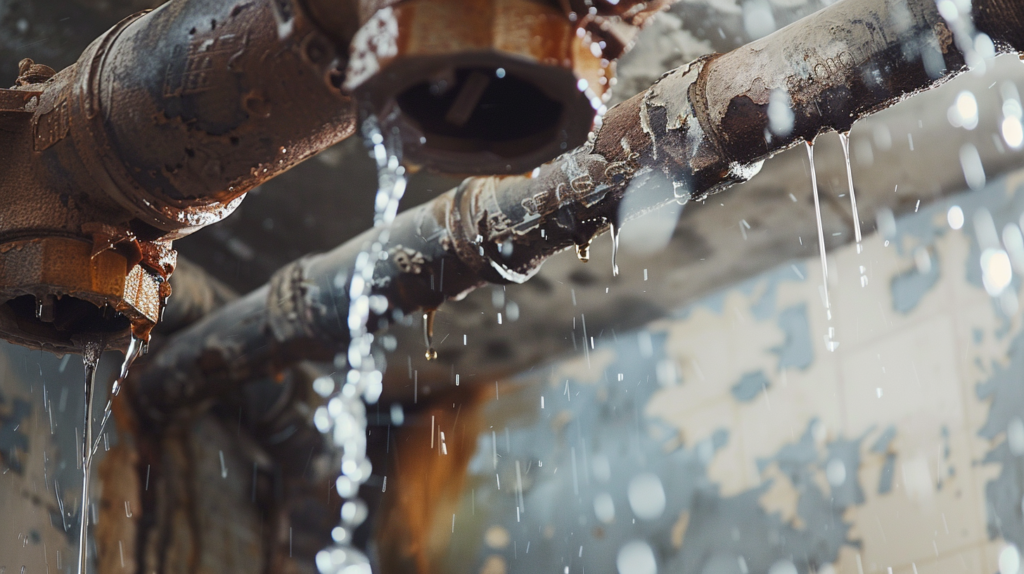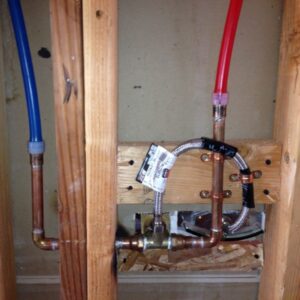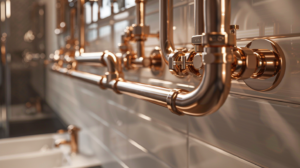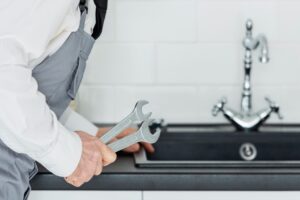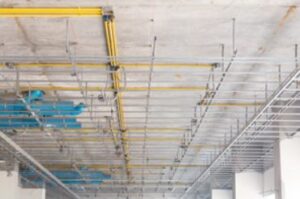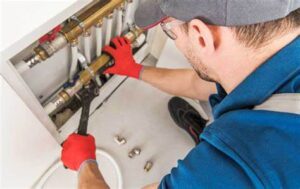Repiping a house becomes necessary when issues like water discoloration and low pressure signal potential pipe deterioration. The cost varies based on several factors, making it crucial to weigh the need for repiping against the long-term benefits. Understanding why repiping is essential and how much it might cost can help homeowners make informed decisions about their property’s infrastructure.
Key Takeaways
- Repiping is needed for improved water quality, increased property value, and to prevent costly repairs.
- Signs like low water pressure, discolored water, and leaks indicate the necessity of repiping.
- Material choice, property size, and installation complexity impact the cost of repiping a house.
- Modern pipes are more efficient, durable, and resistant to corrosion, enhancing the overall plumbing system.
- Hiring professionals ensures quality work, adherence to regulations, and prevents future issues, offering peace of mind.
Signs of Needing Repiping
When water discoloration, low water pressure, and frequent leaks occur, these are common signs indicating the necessity for repiping a house. Rust or corrosion in the pipes can lead to water discoloration, which results in brown or reddish water. Low water pressure may result from mineral buildup or pipe deterioration restricting water flow. Frequent leaks often signal that the pipes have weakened and are no longer structurally sound.
Discolored water isn’t only aesthetically unpleasing but can also indicate potential health hazards due to rust or contaminants leaching into the water supply. Low water pressure can disrupt daily activities like showering or washing dishes, impacting the overall convenience and functionality of the plumbing system. Frequent leaks not only waste water but can also cause water damage to the property if left unaddressed.
Understanding these signs is crucial for homeowners to recognize when repiping is necessary to maintain a safe and efficient plumbing system within their house.
Types of Piping Materials
Various piping materials are commonly used in household repiping projects, each with its own set of advantages and disadvantages. Understanding the pros and cons of materials like copper, PEX, PVC, and CPVC is crucial in making informed decisions regarding repiping a house.
Factors such as durability, cost-effectiveness, and ease of installation play pivotal roles in determining the most suitable piping material for a specific project.
Common Piping Materials
Common piping materials used in repiping projects include copper, PEX, and CPVC. Copper piping, known for its durability and resistance to corrosion, has been a popular choice for decades due to its long lifespan.
PEX (cross-linked polyethylene) tubing is flexible, making it easy to install in various applications. It’s also resistant to scale and chlorine, enhancing its longevity.
CPVC (chlorinated polyvinyl chloride) piping is suitable for both hot and cold water distribution and is known for its affordability and ease of installation.
Each material has its own unique characteristics, and the choice of piping material depends on factors such as budget, local building codes, and specific project requirements.
Pros and Cons
Copper, PEX, and CPVC are widely used piping materials in repiping projects, each with distinct pros and cons that influence their suitability for different applications.
Copper pipes are durable, resistant to extreme temperatures, and have a long lifespan, but they can be expensive and may corrode over time.
PEX pipes are flexible, easy to install, and resistant to corrosion and freezing, yet they may not be suitable for outdoor use due to UV sensitivity.
CPVC pipes are cost-effective, easy to install, and resistant to most chemicals, but they may not withstand high temperatures and can become brittle over time.
Understanding the pros and cons of each material is crucial in determining the most suitable option for a repiping project.
Factors Affecting Repiping Costs
Factors that significantly impact the cost of repiping a house include the size of the property, the type of piping material chosen, and the complexity of the installation process.
The size of the property directly affects the amount of piping required, thus influencing overall costs. Larger properties will naturally require more piping, leading to increased material and labor expenses.
The type of piping material selected also plays a crucial role in determining the total cost. For instance, materials like copper are more expensive upfront but tend to be more durable and have lower maintenance costs in the long run compared to alternatives like PEX or PVC.
Moreover, the complexity of the installation process can substantially impact the final expenses. Factors such as the layout of the property, accessibility to plumbing systems, and the need for additional equipment or specialized techniques can all contribute to higher repiping costs.
It’s essential for homeowners to consider these factors carefully when planning a repiping project to ensure an accurate budget estimate.
Benefits of Repiping a House
Repiping a house offers significant benefits, such as improved water quality and increased home value. By replacing old, corroded pipes with new, efficient ones, homeowners can enjoy cleaner and safer drinking water.
Additionally, the investment in repiping can lead to a higher resale value for the property.
Improved Water Quality
Enhancing the water quality of a house through repiping can significantly improve overall health and well-being for the occupants. Old pipes can deteriorate over time, leading to rust, corrosion, and the buildup of harmful contaminants in the water supply. By repiping the house with modern materials such as copper or PEX, the chances of water contamination are greatly reduced.
Improved water quality means cleaner, safer water for drinking, cooking, and bathing. It also helps prevent health issues associated with consuming or being exposed to contaminated water. Repiping ensures that the water flowing through the house is fresh, clear, and free from any harmful substances, promoting a healthier living environment for everyone.
Increased Home Value
Increasing the value of a home can be achieved through the process of repiping, as it enhances the overall functionality and desirability of the property. When a house has outdated or damaged pipes, it can lead to issues like leaks, low water pressure, and water damage, which can significantly decrease its value.
DIY Vs. Professional Repiping
When considering whether to tackle the repiping of a house on your own or hire a professional such as Gladiator Plumbing & Repipe, it’s crucial to evaluate the complexity of the project and your level of expertise in plumbing. DIY repiping can be tempting due to cost savings, but it’s essential to recognize the challenges involved. Repiping a house requires a solid understanding of plumbing systems, the ability to navigate tight spaces, and familiarity with local building codes. Professionals bring specialized knowledge, experience, and tools to the table, ensuring the job is done efficiently and up to standard.
While a DIY approach may seem cost-effective upfront, errors could lead to leaks, water damage, or even mold growth, resulting in higher repair costs in the long run. Hiring a professional for repiping guarantees quality workmanship, adherence to regulations, and peace of mind. Additionally, professionals can identify underlying issues that an untrained eye might miss, preventing future complications. Ultimately, the decision between DIY and professional repiping depends on one’s comfort level with plumbing tasks, the complexity of the project, and the importance of a job done right the first time.
Average Cost of Repiping a House
The average cost of repiping a house can vary significantly depending on the size of the property, the materials used, and the complexity of the plumbing system. On average, homeowners can expect to pay between $2,000 and $15,000 for a whole-house repiping job. For a smaller home with minimal plumbing needs, the cost may be towards the lower end of the spectrum, while larger homes with intricate plumbing layouts can result in higher expenses.
The type of material chosen for repiping also plays a crucial role in determining the overall cost. For instance, materials like copper are generally more expensive but offer durability and longevity, potentially reducing maintenance costs in the long run. On the other hand, materials like PEX are more budget-friendly but may require more frequent replacement or repairs.
It is essential to obtain quotes from multiple plumbing professionals to compare costs and assess the scope of work involved. Factors such as labor, permits, and restoration of affected areas should also be considered when budgeting for a repiping project.
Conclusion
In conclusion, the process of repiping a house, although necessary due to various issues, can be seen as an investment in the property’s long-term structural integrity and functionality.
The costs associated with repiping may vary based on factors such as property size and material choice, but the benefits of improved water quality and increased property value make it a worthwhile endeavor for homeowners looking to maintain their home’s overall condition. If you need the opinion of a trusted plumbing company don’t hesitate to reach out to us today to get a free quote!

